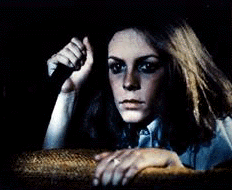



It's useless to take a lofty view on an instant schlock horror classic, but there are reasons why John Carpenter's Halloween, alone in the last decade, stands with George A. Romero's Night of the Living Dead and, before that, with Psycho, in which Hitchcock subverted the subgenre to different ends. The resemblance of Halloween to the Romero film -- an assault on credibility couched in documentary prose -- is the utter implacability of the antagonist, a faceless psychopath of terrifying strength and preternatural ubiquity who lays siege to two households of teenagers. Otherwise, Halloween, a study in warm colors, dark shadows, and ceaselessly tracking dollies, owes much more to the expressive possibilities raised by Vincente Minnelli in the Halloween sequence of Meet Me in St. Louis than to any films in the realistic school.
Psycho invariably comes to mind because of the knife-wielding madman, and, more importantly, because Carpenter has attempted to stretch the shower sequence into as much of a feature film as the traffic will alow. That means there are plenty of pauses -- rest stops that Carpenter fills with a wholesome portrait of small-town Haddonfield, Illinois, and an abundance of in-jokes about babysitters, the local police, and kids on trick-or-treat night watching traditional (not quite schlock) movies like The Thing and Forbidden Planet on local TV.
The trio of teenage girls in Halloween are victims truly worth caring about. They speak more intelligent dialogue and are more attractively contemporary than the hundreds of blithering idiots in all the Universal, Columbia, and Paramount youth films in any given year.Yet Halloween is a movie of almost unrelieved chills and of violence, conjuring up that unique mix of subliminal threat and contrapuntal physicality employed by Hitchcock. Carpenter isn't a disciplined director of narrow strategies and high aims like Hitchcock, but he does blow imitators like Brian DePalma and all his works off the screen. Carpenter's free, eclectic use of the subjective shot is enough to drive purists crazy: he uses it, though, as the basic resource of an unabashedly devious visual labyrinth in which every blank space, curve, and corner poses a threat. Halloween, after all, is a schlock film -- the old one about the masked psycho ignited by any sign of pubescent sexuality. It would seem that Carpenter's duplicitous hype is the most honest way to make a good schlock film. A subplot introduced by Donald Pleasence, in marvelous form as a Cassandra warning about catastrophic massacre, is more disturbing.
At the last minute, Pleasence's machinations attempt to elevate schlock to myth. Perhaps, more accurate parallels to Halloween would be the frisson of the final jump in Wait Until Dark, the ominous trompe-l'oeil sentinels of The Innocents, and the zany cinematic control of Mario Bava in Black Sunday. Put them all together with memories of Night of the Living Dead and Psycho and you have Halloween, the trickiest thriller of the year. This article first appeared in November, 1979, in the Village Voice. More than any other review, it turned the tide among critics, who thereafter looked to Halloween as a genre classic. It was reprinted with permission of the estate of Tom Allen and the Village Voice.
CREDITS
Producer: Debra Hill
Director: John Carpenter
Screenplay: Debra Hill and John Carpenter
Director of Photography: Dean Cundey
Editing: Tommy Lee Wallace and Charles Burnstein
Music: John Carpenter
Production Director: Tommy Lee Wallace
TRANSFER
The Criterion Collection is proud to present Halloween in its original Panavision(r) aspect ratio of 2.35:1. This transfer was made from a newly minted 35mm Panavision print made from the original negative, the 35mm magnetic master mono soundtrack, and the 35mm magnetic mono music and effects track. Footage from the television release is presented full-frame, transfered from the original 1-inch master created for broadcast.

